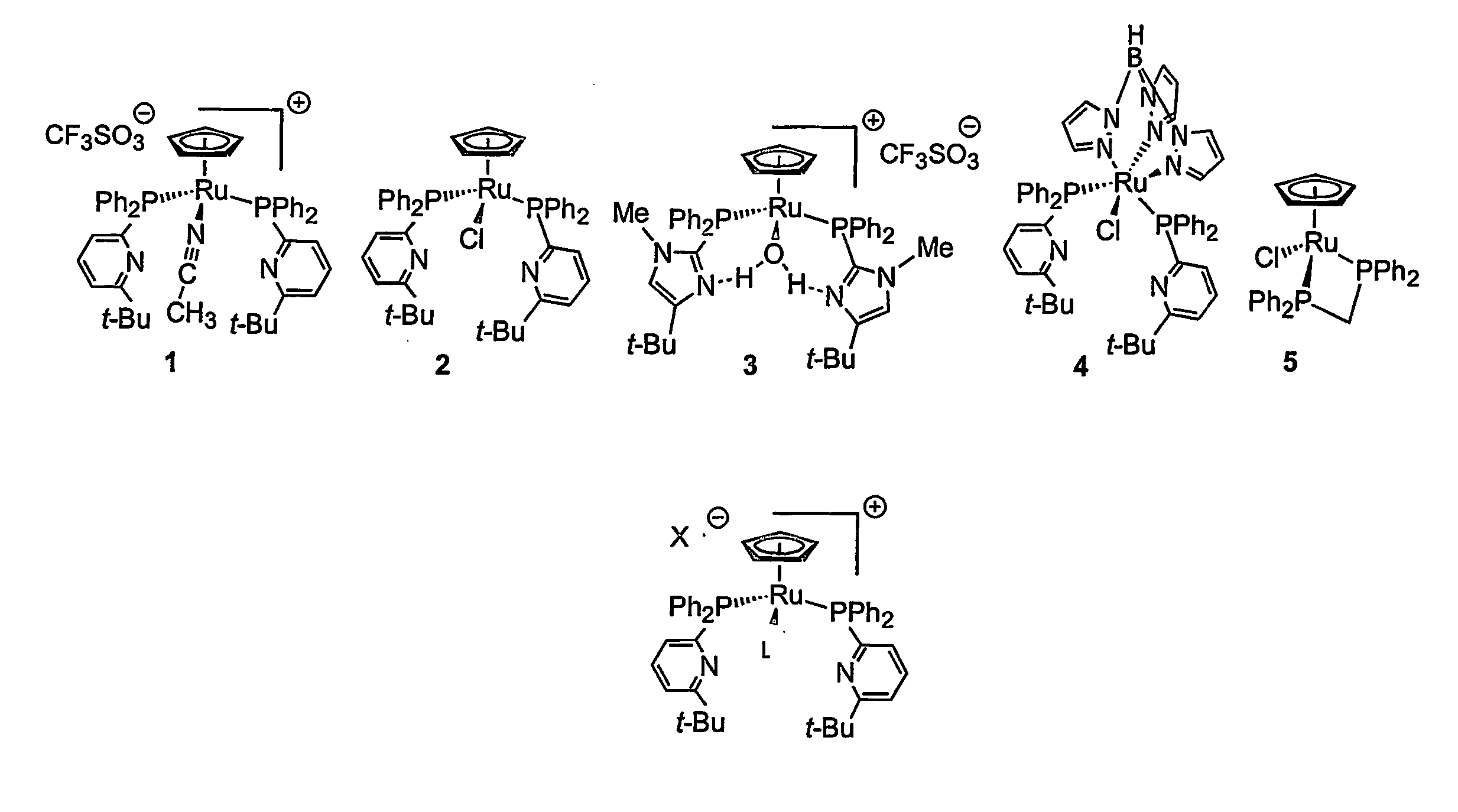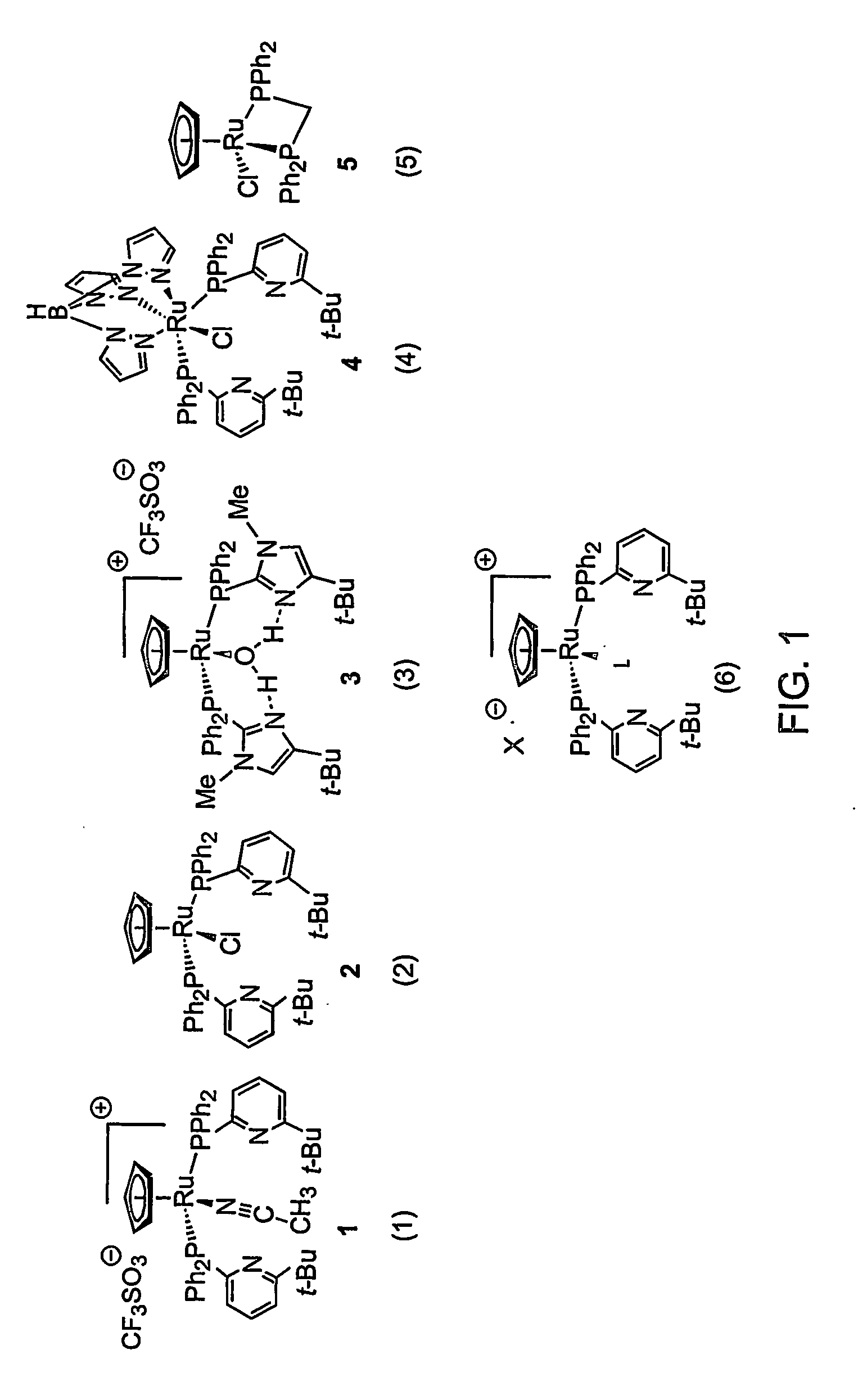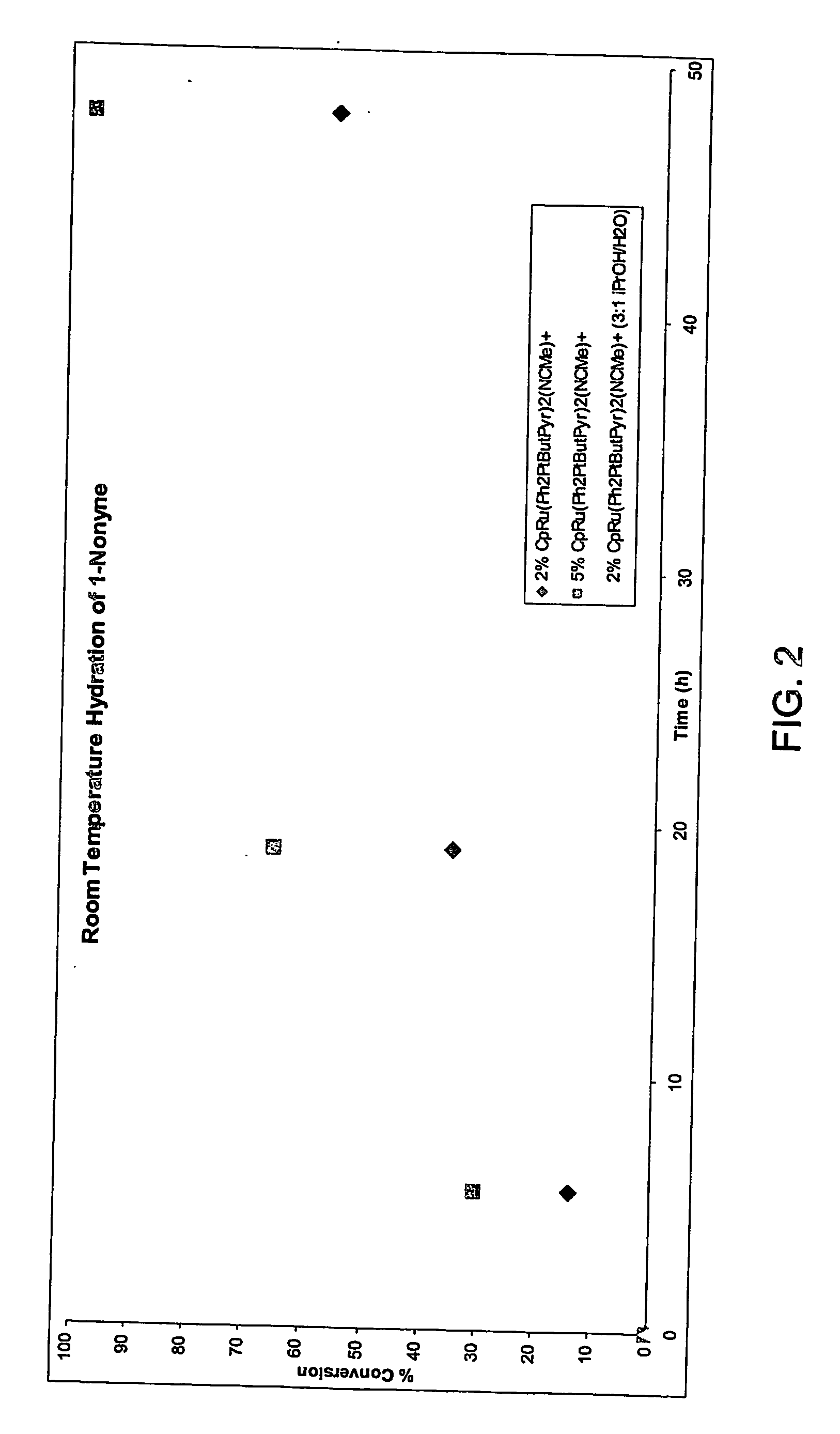Compositions and methods for facilitating reaction at room temperature
a technology of enzymatic systems and compositions, applied in the field of compound or ligands, can solve the problems of 168 years, difficult handling, and difficult breakage of half the amide bond, and achieve the effect of facilitating one or more chemical reactions
- Summary
- Abstract
- Description
- Claims
- Application Information
AI Technical Summary
Benefits of technology
Problems solved by technology
Method used
Image
Examples
example 1
Production of [Cyclopentadienylruthenium(II) bis(2-diphenylphosphino-6-t-butylpyridine) (acetonitrile)][X]
[0043] 5 mL of dry, deoxygenated methylene chloride was added to a 50-mL Schlenk flask containing 0.70 mmol of [cyclopentadienyl ruthenium(II) tris(acetonitrile)] [X] (X=PF6− or CF3SO3−1) under nitrogen. 5 ml of a solution containing 446 mg or 1.40 mmol of 2-diphenylphosphino-6-t-butylpyridine in dry, deoxygenated methylene chloride was added to the flask and the mixture was stirred for 5 h at room temperature. The solvents were removed under high vacuum leaving behind a yellow solid. The solid was washed with 5 mL of deoxygenated pentane two times and then dried under high vacuum producing a yellow microcrystalline powder.
[0044] X=PF6−, 685 mg, 0.69 mmol, 99%. Data for the PF6−1, salt: 1H NMR (CDCl3, 500 MHz) δ 7.44 (tt, J=8.0, 1.7 Hz, 2 H), 7.42-7.36 (m, 4 H), 7.31-7.35 (m, 4 H), 7.30 (dq, J=8.0, 1.1 Hz, 2 H), 7.26 (t, J=7.5 Hz, 4 H), 7.13-7.18 (m, 8 H), 6.65 (dm, J=7.5 Hz, 2...
example 2
Hydration of 1-Nonyne Utilizing [Cyclopentadienylruthenium(II) bis(2-diphenylphosphino-6-t-butylpyridine) (acetonitrile)][X]
[0045] A 2-mL vial was charged with 0.0100 mmol of [Cyclopentadienylruthenium(II) bis(2-diphenylphosphino-6-t-butylpyridine) (acetonitrile)][X], 0.500 mmol of 1-nonyne and 0.0500 mL hexadecane. A solvent system, either 3:1 (v / v) i-propanol / water or acetone with 2.50 mmol water, was then added such that the total final volume was 1.00 mL. The reaction was then heated in a 96-well monoblock heating apparatus. Periodically, 0.0100 mL samples were removed from the reaction mixture, diluted with acetone, and monitored using gas chromatography and an FID detector. Hydration product concentrations were determined using FID response factors calculated from standard solutions.
example 3
Comparison of Initial Rates of the Hydration of 1-Nonyne and Phenylacetylene by Certain Catalysts
Comparison of Initial Rates of the Hydration of 1-Nonyne
[0046] Hydration rates of an alkyne were examined for five compounds, as shown in FIG. 1. Each compound is identified for convenience as (1), (2), (3), (4), or (5). Compound 5 has been previously reported by others in the literature (Suzuki, Tokunaga, and Wakatsuki, Org. Lett. 2001, 3, 735-737). Compound 3 was previously described in Angew. Chem., Int. Ed. Engl. 2001, 40, 3884-3887 disclosed in pending U.S. patent application Ser. No. 09 / 785,911, filed Feb. 16, 2001, which is incorporated in its entirety herein by reference.
[0047] Rates are expressed as % conversion per % catalyst per hour
Iso-propanol / Acetone @H2O (3:1 v / v)Catalyst70° C.@ 70° C.2% CpRu(Ph2PtButPyr)2(CH3CN)+ (1)23.623536.05952% CpRu(Ph2PtButPyr)2Cl (2)2.44825nd2% CpRu(Ph2PtButImid)2(H2O)+ (3)1.8807nd2% TpRu(Ph2PtButPyr)2Cl (4)0.8175nd2% CpRu(dppm)Cl (5)0.02060....
PUM
| Property | Measurement | Unit |
|---|---|---|
| Fraction | aaaaa | aaaaa |
| Time | aaaaa | aaaaa |
| Time | aaaaa | aaaaa |
Abstract
Description
Claims
Application Information
 Login to View More
Login to View More - R&D
- Intellectual Property
- Life Sciences
- Materials
- Tech Scout
- Unparalleled Data Quality
- Higher Quality Content
- 60% Fewer Hallucinations
Browse by: Latest US Patents, China's latest patents, Technical Efficacy Thesaurus, Application Domain, Technology Topic, Popular Technical Reports.
© 2025 PatSnap. All rights reserved.Legal|Privacy policy|Modern Slavery Act Transparency Statement|Sitemap|About US| Contact US: help@patsnap.com



